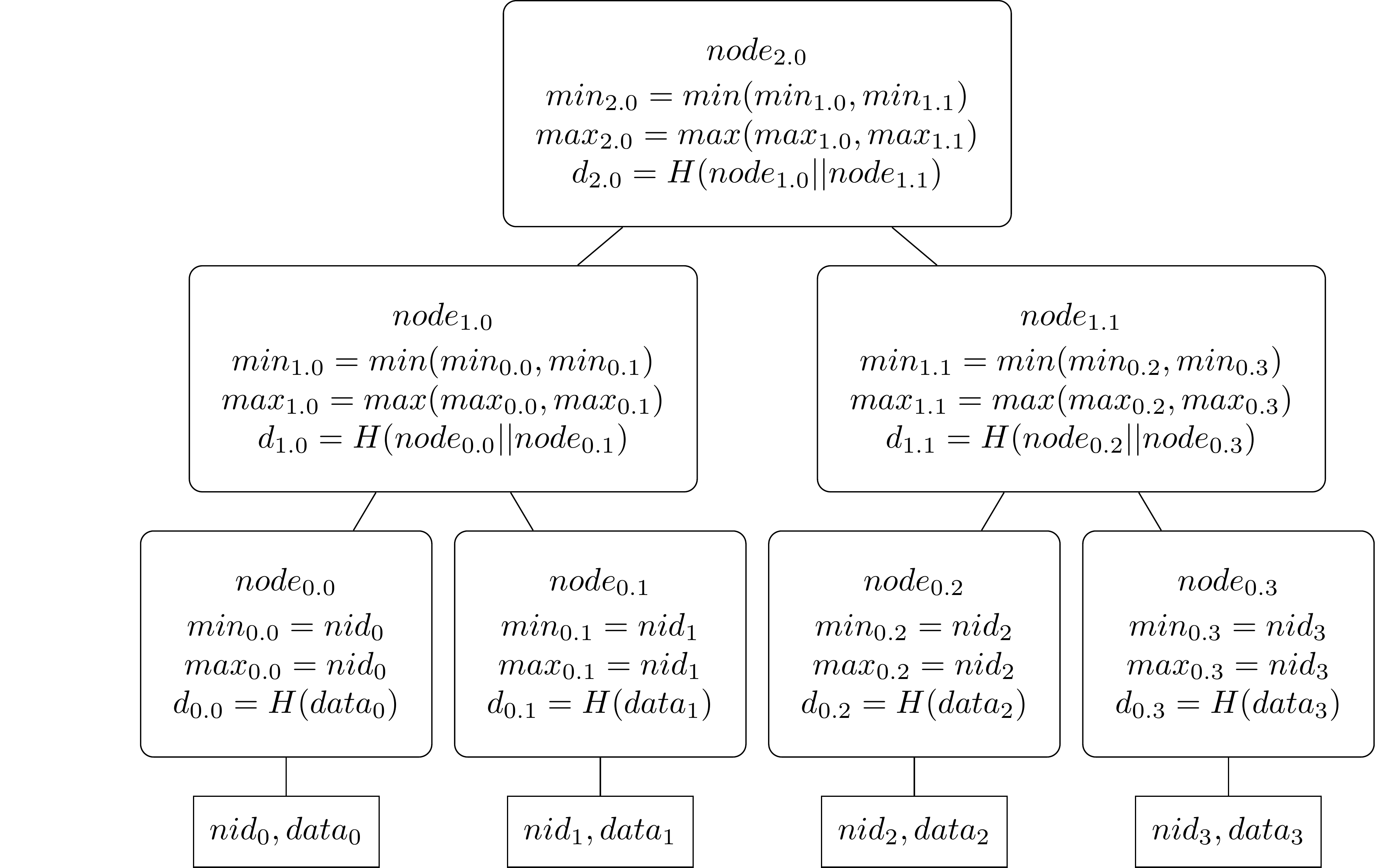A Namespaced Merkle Tree is
[...] an ordered Merkle tree that uses a modified hash function so that each node in the tree includes the range of namespaces of the messages in all of the descendants of each node. The leafs in the tree are ordered by the namespace identifiers of the messages. In a namespaced Merkle tree, each non-leaf node in the tree contains the lowest and highest namespace identifiers found in all the leaf nodes that are descendants of the non-leaf node, in addition to the hash of the concatenation of the children of the node. This enables Merkle inclusion proofs to be created that prove to a verifier that all the elements of the tree for a specific namespace have been included in a Merkle inclusion proof.
The concept was first introduced by @musalbas in the LazyLedger academic paper.
package main
import (
"crypto/sha256"
"fmt"
"github.com/celestiaorg/nmt"
"github.com/celestiaorg/nmt/namespace"
)
func main() {
// the tree will use this namespace size
nidSize := 1
// the leaves that will be pushed
data := []namespace.PrefixedData{
namespace.PrefixedDataFrom(namespace.ID{0}, []byte("leaf_0")),
namespace.PrefixedDataFrom(namespace.ID{0}, []byte("leaf_1")),
namespace.PrefixedDataFrom(namespace.ID{1}, []byte("leaf_2")),
namespace.PrefixedDataFrom(namespace.ID{1}, []byte("leaf_3")),
}
// Init a tree with the namespace size as well as
// the underlying hash function:
tree := New(sha256.New(), NamespaceIDSize(nidSize))
for _, d := range data {
if err := tree.Push(d.NamespaceID(), d.Data()); err != nil {
panic("unexpected error")
}
}
// compute the root
root := tree.Root()
// the root's min/max namespace is the min and max namespace of all leaves:
if root.Min().Equal(namespace.ID{0}) {
fmt.Printf("Min namespace: %x\n", root.Min())
}
if root.Max().Equal(namespace.ID{1}) {
fmt.Printf("Max namespace: %x\n", root.Max())
}
// compute proof for namespace 0:
proof, err := tree.ProveNamespace(namespace.ID{0})
if err != nil {
panic("unexpected error")
}
// verify proof using the root and the leaves of namespace 0:
leafs := [][]byte{
append(namespace.ID{0}, []byte("leaf_0")...),
append(namespace.ID{0}, []byte("leaf_1")...),
}
if proof.VerifyNamespace(sha256.New(), namespace.ID{0}, leafs, root) {
fmt.Printf("Successfully verified namespace: %x\n", namespace.ID{0})
}
if proof.VerifyNamespace(sha256.New(), namespace.ID{2}, leafs, root) {
panic(fmt.Sprintf("Proof for namespace %x, passed for namespace: %x\n", namespace.ID{0}, namespace.ID{2}))
}
}The above will create a Namespaced merkle tree with four leafs which looks like this:
Where nid_0 = nid_1 = 0 and nid_2 = nid_3 = 1 and data_i = "leaf_i" for i = 0,...,3.
This implementation (currently) uses NebulousLabs' merkletree implementation and was heavily inspired by the initial implementation in the celestiaorg prototype.

